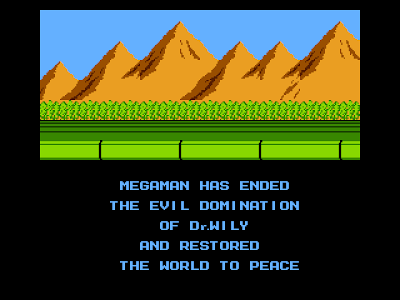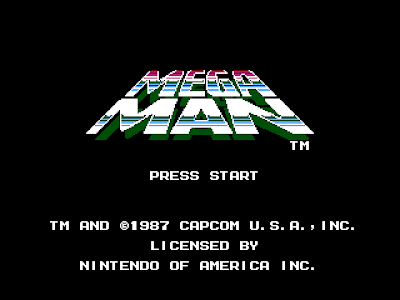This is the first in a series of robotic adventure games made by Capcom. Mega Man (Rockman in Japan) fights against the evil robots and that's pretty much it. Every game in the series follows the same formula: Stage selection of up to eight robot bosses, and once they are defeated you acquire their super robot powers. Then you go to a boss stage or three, repeat some fights, and survive climactic surprise battle after battle against the evil Dr. Wiley. It's a tried and true system that has made Mega Man one of the most popular, and longest series for the NES.
So the game is a platform shooter, and requires a lot of timing, proper use of items and jumping. Mega Man's jumps never seem to quite reach as far as you like, though you'd be surprised how far you'll make it sometimes. Like other NES games you get knocked around when you get hit, so you end up fall in pits or from high places and either die or have to start difficult areas all over again. That's the challenge.
The Art:
Mega Man is known for possibly the worst box art ever created for a video game. The North American version is a frightening thing to behold. Most video game art from the early days of computer games greatly exaggerated the themes of the game, or took artistic liberties that may have been completely at odds with the actual software content. The interesting legacy of bad box art in the Mega Man series has become a theme of sorts that has been revived in the ninth and tenth sequels. |
| North American Version |
 |
| Japanese version |
 |
| European Version |
The Music:
Music for Mega Man was composed by Manami Matsumae. She composed the soundtrack in three months and found that the limitations of the Famicom's music capabilities to be challenging. She was also a member of Capcom's house band Alph Lyla who's work included the Street Figher II theme. She composed the songs for many games, notably the Derby Stallion series during the 1990's. Matusumae recently returned to create the soundtrack of Mega Man 10 in 2010.
The soundtrack of Mega Man is known for it's sense of urgency and fast tempos. While it isn't as memorable as the next two sequels, it did establish the music for stage selection, game overs, and boss fights. It seems different from other game soundtracks, with a definite futuristic or science fiction feel to it. There are similarities in sound with other Capcom games, which is common among game publishers.
Advertising:
I wonder why Dr. Wiley is the largest character marching with all the bad guys? He's a short old man in the game. I don't think that Capcom made a North American commercial for Mega Man, though they did for all of the sequels. I think they realized they'd have to show that ugly box on television.
The Graphics:
Mega Man established the graphical design for the remainder of the series. Capcom didn't do much to alter the design of Mega Man himself, though the backgrounds and enemies did improve towards the end. I consider this game a little sparse on interesting backgrounds and textures common to the series. I'll cut Capcom some slack because it was the first Mega Man.The Results:
Right off the bat I felt the misery of repetitive vertical climbs and enemies that knock you off ladders and crap. Games like this were designed to knock you back all the time. So it would happen often, and timing your shots while avoiding death below and enemies above was tricky. Falling death mistakes resulted in more deaths than anything else. Selecting the appropriate weapon is crucial to winning. Each robot boss is vulnerable to some other robot boss' weapon, so you have to experiment and think what would be the best in each situation. Once you've figured that out, it is pretty easy. |
| Disappearing blocks make timing jumps difficult. |
 |
| Falling to my death |
Some other things: Total lack of items. Killing enemies in the hope that they might drop some life is just a waste of time. You basically are expected to win with the life you are given at the start of each level. Oh and I'm not sure if its me, but Mega Man slides a little when he moves. Enough that you think you're losing your footing every time you jump. I think they fixed that in later games. There's also a score at the top of the screen. That was dropped in later games.
Well, I managed to fight my way through all the bosses, and then to Dr. Wiley. After failing a few times and selecting the right weapon I managed to beat him pretty easily. Compared to some of the other bosses, it was just a matter of timing my shots, and avoiding his flying hover science craft. I win!
 |
| The final battle with Dr. Wiley and his flying... thing. |
VICTORY
 |
| Or did he? |
Epilogue:
I thought that the game was good. It was awesome to see where the series got started. The game was short, and while most of the boss stages were simple enough to beat though, the last four Dr. Wiley stages were brutal. But I expected that, and I think all of the Mega Mans have brutal last stages. There are some bugs in the game that may or may not have helped me finish the last stage. Dr. Wiley was a pushover compared to some other bosses. The ending was cool enough watching Mega Man run like crazy while the end credits blazed past. I thought it would take me longer, but after two and a half hours that was it. Done.
Statistics:
Deaths: 66 Continues: 22 Game Overs: 22 High Score: 314300 Time: 2:40:00
 |
| "Calm After the Storm" by Robert Kim |
Mega Man®, and all associated video games, music, characters, etc. are owned by Capcom - all rights reserved.




you can never TRULY kill the flying_hover_science_craft! I want to play megaman x now. the one i played on SNES a million times. man i love that game.. and the music.
ReplyDeleteI've never really played any of the SNES Mega Mans. They look awesome though. the music is really good.
ReplyDelete